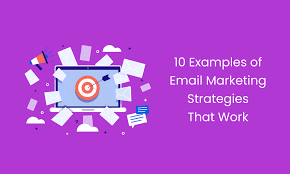Email marketing is a powerful tool for businesses to connect with their audience and drive sales. However, simply sending out mass emails without a strategy in place can be ineffective and even harmful to your brand’s reputation. In this article, we will discuss the key components of a successful email marketing strategy.
- Define Your Goals: Before launching an email campaign, it’s essential to define your goals. What do you hope to achieve with this campaign? Is it increasing sales, driving website traffic, or building brand awareness? Once you have defined your goals, you can tailor your email content and calls-to-action accordingly.
- Build Your Email List: Your email list is the foundation of your email marketing strategy. It’s essential to build a quality list of subscribers who are interested in your product or service. One way to do this is by offering a lead magnet such as an ebook or discount code in exchange for their email address.
- Segment Your List: Not all subscribers are the same, and therefore not all emails should be the same either. Segmenting your list based on demographics, interests, and behavior allows you to send targeted messages that resonate with each group.
- Craft Compelling Content: Your content should be engaging and relevant to your audience. Use attention-grabbing subject lines and personalize the message with their name or other relevant information. Keep the message concise and include a clear call-to-action.
- Test and Optimize: Testing different elements of your email campaigns such as subject lines, content, and send times can help optimize their performance over time. Analyze the data from each campaign to identify what worked well and what needs improvement.
- Follow Up: Follow up emails are an excellent opportunity to nurture leads that did not convert on the first touchpoint. Send personalized follow-up messages based on their behavior or interests.
In conclusion, having an effective email marketing strategy can help businesses reach their goals by connecting with their audience and driving sales. By defining your goals, building a quality email list, segmenting your list, crafting compelling content, testing and optimizing, and following up, you can create a successful email marketing campaign.
Mastering Email Marketing: Answers to 5 Common Strategy Questions
- What are the best practices for email marketing?
- How can I increase my email open rate?
- What is the most effective way to segment my email list?
- How can I improve my click-through rates for emails?
- What are the latest trends in email marketing that I should be aware of?
What are the best practices for email marketing?
Email marketing can be a highly effective way to reach and engage with your audience, but it’s important to follow best practices to ensure your emails are well-received and achieve their intended goals. Here are some of the top best practices for email marketing:
- Build a quality email list: Your email list should consist of people who have given you permission to contact them, such as subscribers who have opted into your newsletter or customers who have made a purchase from your website. Avoid purchasing or renting email lists as these contacts haven’t given you permission to contact them and may not be interested in your content.
- Segment your email list: Not all subscribers are the same, so segmenting your list based on demographics, interests, and behavior can help you send more targeted messages that resonate with each group.
- Personalize your emails: Use merge tags to personalize the message with the recipient’s name or other relevant information. This can help increase engagement and make the recipient feel valued.
- Use attention-grabbing subject lines: Your subject line is the first thing recipients see when they receive your email, so make it compelling and relevant to the content of the message.
- Keep your content concise: People receive a lot of emails every day, so keep your message concise and focused on one main topic or call-to-action.
- Include a clear call-to-action: Make it clear what action you want recipients to take after reading your email, whether it’s visiting your website, making a purchase, or subscribing to a service.
- Test and optimize: Test different elements of your emails such as subject lines, content, send times, and calls-to-action to identify what works best for your audience.
- Monitor deliverability rates: Ensure that your emails are being delivered successfully by monitoring deliverability rates and taking steps to improve them if necessary.
By following these best practices for email marketing, you can create engaging and effective campaigns that help you connect with your audience and achieve your business goals.
How can I increase my email open rate?
The open rate of your emails is a critical metric to measure the effectiveness of your email marketing campaign. A low open rate can mean that your subscribers are not engaged with your content or that your emails are not reaching their inbox. Here are some tips to increase your email open rate:
- Write compelling subject lines: Your subject line is the first thing that your subscribers see in their inbox, and it can make or break whether they decide to open your email. Make sure to write a concise, attention-grabbing subject line that accurately reflects the content of your email.
- Personalize your emails: Personalization can make a big difference in whether someone decides to open an email. Use their name or other relevant information in the subject line or opening sentence of the email.
- Segment your list: Segmenting your list based on demographics, interests, and behavior allows you to send targeted messages that resonate with each group. This can lead to higher engagement and a higher open rate.
- Send at the right time: Timing is key when it comes to sending emails. Experiment with different send times and days of the week to see what works best for your audience.
- Keep it concise: Keep the body of your email short and sweet, with a clear call-to-action at the end.
- Clean up your list: Regularly clean up your email list by removing inactive subscribers or those who have marked you as spam. This will help improve deliverability rates and increase engagement from active subscribers.
By implementing these strategies, you can increase the likelihood that recipients will open and engage with your emails, leading to a more successful email marketing campaign overall.
What is the most effective way to segment my email list?
Segmenting your email list is an essential part of any successful email marketing strategy. By dividing your list into smaller groups based on specific criteria, you can send targeted messages that resonate with each group. Here are some effective ways to segment your email list:
- Demographics: Segmenting by demographics such as age, gender, location, and income can help you tailor your message to each group’s unique needs and interests.
- Behavior: Analyzing subscriber behavior such as past purchases, website activity, and email engagement can help you send targeted messages that encourage them to take action.
- Interests: Segmenting by interests such as hobbies or preferences can help you send relevant content that resonates with each subscriber.
- Customer Lifecycle Stage: Segmenting based on where a customer is in their journey with your brand (e.g., new customer, repeat customer, lapsed customer) allows you to send targeted messages that address their specific needs.
- Email Engagement: Segmenting based on how subscribers interact with your emails (e.g., opens, clicks, conversions) allows you to send follow-up messages that are tailored to their level of engagement.
Ultimately, the most effective way to segment your email list will depend on your business’s unique goals and audience. It’s essential to analyze data from previous campaigns and test different segmentation strategies to identify what works best for your business.
How can I improve my click-through rates for emails?
Improving click-through rates (CTR) for emails is essential to the success of your email marketing campaigns. A high CTR means that your subscribers are engaging with your content and taking action, which can lead to increased sales and revenue. Here are some tips to improve your email CTR:
- Personalize Your Emails: Personalization can increase engagement and make subscribers feel valued. Use their name in the subject line or greeting, segment your list based on demographics, interests, and behavior, and tailor your content accordingly.
- Write Compelling Subject Lines: Your subject line is the first thing subscribers see in their inbox, so it needs to be attention-grabbing and relevant to the content of the email. Use action-oriented language and keep it concise.
- Optimize Your Preview Text: Preview text is the snippet of text that appears below or next to the subject line in an email inbox. It’s an excellent opportunity to provide additional context or entice subscribers to open the email.
- Include a Clear Call-to-Action: The purpose of an email is often to get subscribers to take action, whether it’s clicking a link or making a purchase. Make sure you include a clear call-to-action (CTA) that stands out visually and is easy for subscribers to click.
- Segment Your List: Segmentation allows you to send targeted messages that are more likely to resonate with each group of subscribers. By sending relevant content based on their interests or behavior, you can increase engagement and CTR.
- Test Different Elements: Testing different elements such as subject lines, CTAs, and send times can help optimize performance over time. Analyze data from each campaign to identify what worked well and what needs improvement.
- Optimize for Mobile Devices: With more people checking their emails on mobile devices than ever before, it’s crucial that your emails are optimized for mobile screens. Use responsive design techniques to ensure your content is easy to read and navigate on smaller screens.
In conclusion, improving your email CTR requires a combination of personalization, compelling subject lines and preview text, clear CTAs, segmentation, testing, and optimization for mobile devices. By implementing these tips, you can increase engagement and drive more clicks to your website or landing pages.
What are the latest trends in email marketing that I should be aware of?
As a language model AI, I don’t have access to the latest news and trends. However, here are some of the recent trends in email marketing that you may want to explore:
- Interactive Emails: Interactive emails are becoming more popular as they provide a more engaging experience for the recipient. These emails may include surveys, quizzes, or even games that encourage interaction and increase engagement.
- Personalization: Personalization goes beyond just addressing the recipient by name. It involves tailoring the content of the email to their interests, behavior, and preferences. This can be achieved through segmentation and automation.
- Mobile Optimization: With more people accessing their emails on mobile devices, it’s essential to optimize your emails for mobile viewing. This includes using responsive design and keeping the content concise.
- AI-Powered Email Marketing: Artificial Intelligence (AI) is being used in email marketing to analyze data, automate tasks, and personalize content. This allows businesses to create more targeted campaigns and improve their overall performance.
- Video in Emails: Video is becoming increasingly popular in email marketing as it provides a more immersive experience for the recipient. Videos can be used to showcase products or services or provide educational content.
- Social Media Integration: Integrating social media into your email marketing strategy can help increase engagement and reach a wider audience. This can include adding social sharing buttons or including user-generated content in your emails.
Overall, staying up-to-date with the latest trends in email marketing can help you create more effective campaigns that resonate with your audience and drive results for your business.



